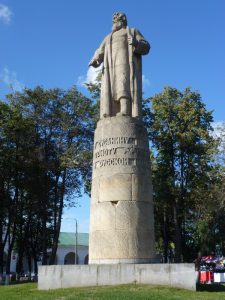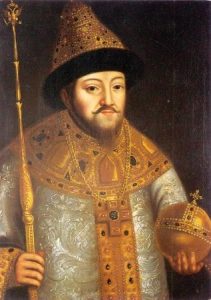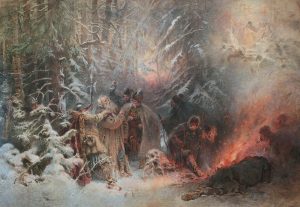
On December 9, 1836 (or November 27, 1836 in the old style, Russian Julian calendar), Mikhail Glinka’s opera A Life for the Tsar received its premiere at the Imperial Bolshoi Theater in St. Petersburg, Russia. More than just an opera and a premiere, the opening night of A Life for the Tsar – 183 years ago today – marks the moment that a tradition of cultivated Russian music came into existence!
Mikhail Glinka (1804-1857) was the right musician at the right place at the right time. Born in the village of Novospasskoye, in the Smolensk Oblast (or “province”), he came from a wealthy, highly cultured, land-owning family. As a child he studied piano and violin and received a first-rate education, first at the hands of his governess Varvara Fedorovna Klammer, and then in St. Petersburg at the Blagorodny School, an exclusive private school for the children of nobility. When he graduated, he did what young men of his class did, and that was take a cushy civil service job. In Glinka’s case, he became assistant secretary of the Department of Public Highways.
It was a do-next-to-nothing, light-weight post, one that allowed Glinka lots of time to indulge his musical interests: playing piano and composing drawing-room music for the amusement of his high-society friends in St. Petersburg’s toniest salons.
And then something in Glinka clicked (might we say “Glinked”?). Tired of his dilettante existence, Glinka – already in his mid-twenties – decided that he wanted to be a real composer. His family was against it, but in 1830, at the age of 26, Glinka left home. Three years in Italy (including a stay at the Milan Conservatory) were followed by a year of intense study in Berlin.
Glinka learned his lessons well. When he returned to St. Petersburg in 1834, he was determined to compose an opera that would be recognizably, authentically Russian.
Glinka got involved in a high-end salon run by the Imperial Court poet Vasily Andreyevich Zhukovsky (1783-1852). It was through Zhukovsky that Glinka got to meet and be inspired by a group of artists who were in the process of defining Russian literature and art and putting it on the international map. Dropping names faster that gulls drop guano, Glinka recalled:
“I continued to visit Zhukovsky in the evenings. He was living at the Winter Palace, and each week a select group gathered there. To mention a few: [Alexander] Pushkin, Prince Petr Vyazemsky, [Nikolai] Gogol, and [the poet and critic Petr] Pletnev. [Various] others turned up as well. Sometimes, instead of [a] reading, there would be singing and piano playing. When I mentioned my desire to undertake a Russian opera, Zhukovsky wholeheartedly approved my intention and suggested a subject: Ivan Susanin.”

Background.
The period between 1598 and 1613 is known in Russian history as the “Time of Troubles.” And that it was: a catastrophic time of dynastic struggles and pretenders to the throne of the Tsars; famine; and invasion and occupation by the hated Polish-Lithuanian Commonwealth.
On February 21, 1613, a sixteen-year-old nobleman (nobleboy?) named Mikhail Romanov was elected Tsar of Russia by a Grand National Assembly. Having elected Mikhail Romanov Tsar, there was a priceless moment when it was realized that no one knew where he was. He was finally tracked down at the Ipatiev Monastery near the city of Kostroma, about 150 miles northeast of Moscow. When he was informed that he’d been elected Tsar, he reportedly burst into tears, no doubt aware that the Tsars of recent memory had rather short shelf lives.

But consent to be Tsar and rule well Mikhail did, for 32 years, until his death at age 49 in 1645. His reign saw an end to the Time of Troubles, and Romanov Tsars would rule for 304 years, until the abdication of Nicholas II in 1917.
But according to legend, the Romanov Dynasty almost didn’t happen. Despite having been recently defeated in Moscow, there was still a Polish military presence in the countryside around Moscow. A Polish cavalry detachment got word that the search was on for the newly elected Tsar – Mikhail Romanov – and that he was very likely holed up at the Ipatiev Monastery near Kostroma. In the woods near the monastery the Poles met a logger named Ivan Susanin; they asked for directions to the monastery. “Oh sure, I know the place. I know a great shortcut!” Deep into the woods they went, and there they disappeared, never to be heard from again. It is assumed that the Poles killed Ivan once his duplicity had been discovered, and that they themselves froze to death trying to find their way back out.

Back to Mikhail Glinka.
When the Imperial Court poet Zhukovsky suggested that Glinka compose an opera about Ivan Susanin, he – Glinka! – didn’t have to be told twice. The story resonated with Glinka for two ginormous reasons. One, it is about the unswerving willingness of Ivan Susanin – a Russian “everyperson” – to sacrifice everything for his Tsar who was the very embodiment of the Russian state. Two, it is about fighting off foreign invaders, the great bugaboo of the Russian mind. Let us not forget that Napoleon’s invasion of Russia had occurred just 23 years before Glinka’s opera was composed and that peasant partisans à la Ivan Susanin had played an important role in Napoleon’s defeat. The theme of unswerving loyalty to the Tsar in the face of a foreign threat was as contemporary to Glinka as it was in 1613, when the events depicted in his opera presumably took place.
A Life for the Tsar received its premiere in St. Petersburg at the Bolshoi Theater on Friday, December 9, 1836, with the Imperial family in attendance.
The premiere was a triumph. Glinka remembered:
“The success of the opera was complete. I was in a daze and cannot remember to this day just what happened when the curtain came down. Right afterwards, though, I was called to the imperial box. The Tsar [Nicholas I] thanked me for my opera. After he had thanked me, the Tsarina did so, too, and then all the Grand Dukes and Grand Duchesses. I soon received an imperial gift for my opera: a four-thousand-ruble ring made up of topaz encircled by three rows of the finest diamonds.”
Glinka’s working title for the opera had been “Ivan Susanin”. However, he changed the title immediately before the premiere to A Life for the Tsar in order to be “allowed” to dedicate the opera to Nicholas I. Glinka’s “reward” for the dedication was the ring.
A Life for the Tsar was not just a triumph for Glinka; it was a triumph for Russian art and culture, taken as widely as we please. It was embraced as the first great “Russian” musical work. It was the first Russian opera to be known outside of Russia. Following its premiere in 1836, A Life for the Tsar opened every opera season in St. Petersburg and Moscow until 1917, the year of the Revolution.
So: What’s So Special About A Life for the Tsar?
It wasn’t that A Life for the Tsar was the first opera produced in Russia; that event had occurred back in 1735, when Empress Ann – the niece of Peter the Great – imported an Italian opera company to St. Petersburg to perform contemporary Italian opera. Neither was A Life for the Tsar the first Russian language opera composed and produced in Russia by a Russian. That distinction goes to a comic opera entitled Misfortune on Account of a Coach of 1779, by a court musician named Vasily Pashkevich, 1742-1797.
Having said all of that, Glinka’s A Life for the Tsar was considered by his contemporaries to be the first real Russian opera for four reasons.
Reason number one: rather than use Russian folk songs or folk-like music for “effect”, the entirety of A Life for the Tsar is imbued with the sensibility of Russian song. A contemporary critic of Glinka’s named Yanuariy Neverov addressed this issue when he wrote:
“[Glinka] has looked deeply into the character of our folk music, has observed all its characteristics, has studied and assimilated it – and then has given full freedom to his own fantasy, [thus creating] images that are purely Russian, native, clear, comprehensible, familiar to us simply because they breathe a pure narodnost’ [an embodiment of the nation], because we hear in them native sounds.”
Reason number two has to do with the specifics of Glinka’s text setting, particularly the recitatives. Glinka creates a recitative style that reflects brilliantly the idiosyncratic sounds and rhythms of the Russian language.
Reason number three: late compositional bloomer though he was, Glinka created in A Life for the Tsar a full-length, up-to-date, cosmopolitan opera, an opera written in a “high style”. Like contemporary Italian opera, A Life for the Tsar is fully sung, with accompanied recitatives, virtuoso arias, multi-part ensembles, and blockbuster finales. Like contemporary French opera, A Life for the Tsar employs recurring themes, big choruses, and a second-act ballet sequence (which is as Parisian as dog poop on the sidewalk). Like contemporary German opera, A Life for the Tsar is harmonically complex and exploits its orchestra to rich effect. All of this sophisticated (if eclectic) cosmopolitanism – employed in the service of a Russian opera – dazzled contemporary Russian audiences, who were thrilled that one of their own had created an opera that could compete, on equal terms, with anything being composed in the West.
Fourth and finally, as a nationalist story portraying a heroic peasant defending his nation from invading outsiders, A Life for the Tsar spoke directly to the pride and patriotism of Russia’s middle and upper classes. As for the ruling class, well, they adored the opera, because it reaffirmed the status quo: Russia’s divinely ordained autocracy and the peasantry’s submission to that autocracy.
At seemingly every level, A Life for the Tsar rang with “authenticity” for contemporary audiences; it was a serious, Russian language opera product that deployed its “Russianisms” intrinsically and not just decoratively; an opera that portrayed Russians behaving the way Russians believed Russians should behave. Overnight and forever after, Mikhail Glinka came to be considered the godfather of “cultivated” Russian music.

For lots more on Glinka, A Life for the Tsar, and the Time of Troubles, I would direct your attention to my course Music as a Mirror of History, produced by The Great Courses/The Teaching Company and available for examination and download at RobertGreenbergMusic.com (and on sale through December 27). I would recommend joining me on my Patreon channel.
Music History Monday Podcast
Podcast: Play in new window
Subscribe: Apple Podcasts | Spotify | Pandora | iHeartRadio | RSS | More
